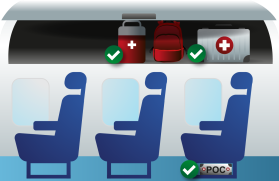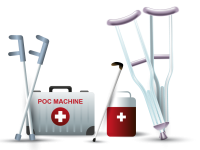Stowing Devices

Assistive devices are generally allowed onboard the aircraft, however, due to space and/or safety limitations, some assistive devices may be required to be stowed in the cargo area of the aircraft. Small assistive devices may be stowed in close proximity to a passenger's seat (under their seat or in the overhead compartment) and do not count toward an airline's carry-on item limit. Assistive devices generally take precedence over other baggage.

Assistive devices have priority for in-cabin storage space (including in closets) over other passengers’ items brought onboard the aircraft by other passengers or crew enplaning at the same airport if the passenger with a disability chooses to pre-board. Assistive devices permitted within the aircraft cabin include:









Assistive devices may be stowed in the cargo area as checked baggage if:
- The device is too large to fit in the designated area
- The device cannot be safely stowed in close proximity to the owner
- An assistive device is already occupying a designated area
Aircraft with 100 or more seats must have priority space for stowing a passenger’s folding wheelchair in the cabin. This spot is awarded on a first-come, first-served basis. Wheelchairs shall be stowed in the onboard designated area for assistive devices (a closet, a row of seats using seat strapping, or other storage space) if the device fits.
Passengers may provide airlines with written instructions on how to take apart their wheelchair if necessary. Airlines are required to carry out these instructions to the greatest extent feasible, consistent with FAA, PHMSA, TSA, or applicable foreign government requirements concerning security, safety, and hazardous materials with respect to the stowage of carry-on items.
Powered or manual wheelchairs that do not break down to fit in a designated priority space in the cabin of the aircraft are not required to be carried in the cabin, but must be stowed in the cargo portion of the aircraft. Upon request, foldable wheelchairs that fit in the designated priority area of the aircraft cabin are required to be stowed in that area given that the area is not already occupied by another assistive device.
If you are a carrier that uses the seat-strapping method to stow a manual passenger wheelchair, you must ensure that there is priority space for at least two such wheelchairs, if stowing the second passenger wheelchair would not displace passengers.
Damaged/Inadequately Secured Batteries
A damaged or leaking battery should not be transported. Damaged or leaking batteries must be removed from the assistive device and packaged separately.
Non-spillable Batteries
You must allow non-spillable batteries labeled as ‘non-spillable’ by a manufacturer to remain installed on a device when stowed onboard the aircraft; and you must not require separate packaging.
Spillable Batteries
If a battery-powered wheelchair with a spillable battery can be loaded, stored, secured, and unloaded in an upright position, you must not require the battery to be removed and separately packaged. You must remove a spillable battery that is installed on a wheelchair that cannot be loaded, stowed, secured, and unloaded in an upright position.
You must return passengers' wheelchairs, other mobility aids, and other assistive devices in a timely manner as close as possible to the door of the aircraft, so that passengers may use their own equipment to the extent possible.
Wheelchairs and other assistive devices must be among the first items retrieved from the baggage compartment.
Passengers may request that their wheelchairs or other assistive devices be returned to them at the baggage claim area instead of the door of the aircraft.
